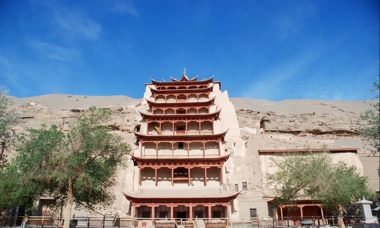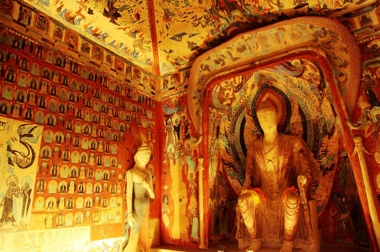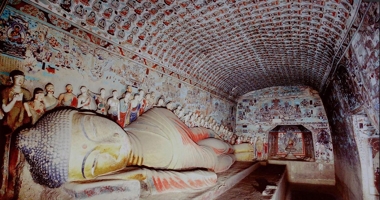Mogao Gottoes
Set on the edge of the Silk Road, Dunhuang may seem like an unlikely place to find an oasis of Buddhist art. With towering dunes in the background, the caves here reflect the power of divine inspiration.
Mogao Grottoes lies on the cliff west of Dangquan River between Sangwei Hills and Mingsha Mountain, 25km to the southeast of Dunhuang. Mogao Grottoes is a shrine of Buddhist art treasures. Dunhuang culture is also known as Mogao Grottoes culture. Located at a strategic point along the ancient Silk Road, the Mogao Grottoes, also known as the Thousand-Buddha Caves, are noted for its rich collection of over 1,000-year-old Buddhists statues and murals.
What to Know About Dunhuang Mogao Grottoes :
According to the Tang Dynasty (618-907) records, a Buddhist monk named Lezun had a vision of a thousand Buddhas under showers of golden rays. Thus inspired, he started construction on the caves, which span ten dynasties. The Mogao Grottoes are commonly known as the Caves of a Thousand Buddhas. With a large number of murals, caves, cultural relics, to name just a few, it is a world-famous Buddhist art resort. Here you can enjoy the magnificent caves and mural art, and learn the history of Buddhism in Dunhuang through explanation and film display, which is the best option for tourists to visit Dunhuang.
The craving for global cooperation and respect to different cultures are part of the reason for China's rise as an ancient superpower. We can find evidence for this in the Mogao Caves. Rediscovered in 1900, the 1,652-year-old Mogao Caves are home to more than 2,000 exquisite sculptures and 45,000 square meters of frescos, featuring many different cultural elements. Here you can find Greek-style columns, abstruse manuscripts written in ancient Hindu, and decorative patterns originating from Persia.
Continue to visit, and you will find some beautiful Buddha statues in the caves such as Flying Apsaras ( Feitian), Kabuki music, fairies, and so on. There are not only sitting statues up to nine stories but also small Bodhisattvas of more than ten centimeters; it is quite numerous and in different shapes, which is worth visiting.
There are more than 492 Grottoes with murals and sculptures in Mogao Grottoes, which divided into five periods: Northern Dynasty, Sui and Tang Dynasties, Five Dynasties and Ten Kingdoms, Song, the Western Xia Regime and Yuan.
As a well-preserved global cultural vault, the Mogao Caves have provided valuable materials for the restoration of some cultural relics along the Belt and Road. For many centuries, the Mogao Caves had been absorbing ideas and culture from Central and Western Asia, as well as Europe. People from these regions can easily find traces of their aboriginal culture here, showcasing the cultural fusion between China and its foreign counterparts.
The Digital Display Centre In Mogao Grottoes:
The Mogao Grottoes Scenic Spot is consists of two parts: the Mogao Grottoes Digital Display Centre and the Mogao Grottoes.
To better preserve the age-old caves, modern technology has adopted to realize the digitalization of the frescoes. Dunhuang Research Academy spent four years on a preservation project called "Digital Dunhuang." It gathers, processes, and saves Dunhuang frescoes and painted sculptures with digital technology to achieve the permanent preservation of Dunhuang artworks.
At the Digital Exhibition Center, visitors can enjoy an immersive experience and witness the rebirth of the masterpieces. Two 30-minute films document the history of the Mogao Grottoes, the Silk Road, and the exclusive cave interiors that are generally not open to visitors.
A "Millennium Mogao" is an introduction to the history and culture of Mogao Grottoes, it will help the tourists to have a better understanding of Mogao Grottoes. Another "Dream Buddha Palace" is a ball screen film that shows a lot of caves that are not open now.
Note: The Mogao Grottoes Scenic Spot is consists of two parts: the Mogao Grottoes Digital Display Centre and the Mogao Grottoes. The two parts adopt a joint ticket system and not sold separately. Since 11th September 2014, the operation of booking visits has implemented in scenic spots. Tourists have to book tickets by telephone or online.
After booking and collecting the tickets, visitors have to go to the digital exhibition center of Mogao Grottoes and watch two films about Mogao Grottoes for 20 minutes each.
Dunhuang Mogao Grottoes Art Protection, Examination and Exhibition Centre:
The exhibition center of Dunhuang grotto art protection has a video studio and three exhibition areas. The video studio showed the art of Dunhuang Grottoes and the general situation of the exhibition center. The eight original large-scale replica caves in the first exhibition area are the outstanding representative caves in various periods of Mogao Grottoes in Dunhuang, showing the artistic style of Dunhuang Grottoes from the 16th country to the Yuan Dynasty for more than 1000 years.
The second exhibition area displays the cultural relics unearthed from Dunhuang Grottoes, including the creation of Dunhuang Mogao Grottoes, Dunhuang mural copy treasures, the creation process of Dunhuang Grottoes and the painting tools used by painters to draw grottoes. The exquisite ancient silk fabrics found in Mogao Grottoes, the authentic ancient manuscripts found in Sutra caves, and the Dunhuang brick-art display units.
The third exhibition area, located on the second floor of the exhibition hall of the exhibition center, is an auxiliary exhibition area, which can hold various exhibitions and unique cultural relics exhibitions.
Dunhuang Academy in Mogao Grottoes:
Dunhuang Research Academy (DHRA) is a comprehensive national institution responsible for the conservation, management, and research of the Mogao Grottoes (a world cultural heritage site at Dunhuang), the Yulin Grottoes (a nationally protected key cultural heritage site at Guazhou), and the Western Thousand-Buddha Grottoes at Dunhuang. As well as the historical and cultural studies, other significant works are also in progress. It includes conservation to restore and consolidate the cliff surface, caves, the statues, and the murals; and digitization, which is to digitize the video and photographs of the caves and the relics inside and to create multi-media virtual tour presentations for the visitors. The exhibitions will allow visitors to see more of the Dunhuang art in greater detail and help conserve the treasures inside the caves.
The cave art in Dunhuang and manuscripts found in the Library Cave provide the world with abundant resources for studying religion, history, geography, politics, economics, art, literature, technology, folk customs, costumes, and astronomy of China and Central Asia. It became a fashionable topic called Dunhuang Studies.
The Influence of Mogao Grottoes Culture:
As one of the well-preserved global cultural vaults, for many centuries, the Mogao Caves had been absorbing ideas and culture from Central and Western Asia, as well as Europe. People from these regions can easily find traces of their aboriginal culture here, showcasing the cultural fusion between China and its foreign counterparts.
Travel Notice of Mogao Grottoes:
The total number of visitors is limited to 6,000 per day, so it is necessary to book your tickets in advance, especially during peak season (1st May to 31st October). One can reserve a ticket online through the official website of Mogao Caves 30 days in advance.
Individual visitors who booked entrance tickets are required to provide their valid ID documents used for the reservation to get their tickets. Foreign visitors can use their passports.
Opening Hours & Entrance Fee
| Opening Hours |
Peak season: 1st May - 31st October ( 8:00-18:00, 15:30 stop entering the scenic spot ) Off-season: 1st November - 30th April ( 9:00-17:30,14:30 stop entering the scenic spot ) |
| Entrance Fee | CNY 258 |
| Recommended Time For Visit | 3 - 5 Hours |
Climate and Weather of Dunhuang Mogao Grottoes:
Dunhuang is a warm temperate arid climate, with little precipitation and large evaporation, the temperature is different between day and night. In winter and summer vary widely from 24.7 °C (76.5 °F) in July to −9.3 °C (15 °F) in January. Sandstorms are frequenters of Dunhuang in March and April. The best seasons with nice weather to visit Dunhuang are summer and autumn, which is to say in August or September. With May to September offering the most clement weather, especially for visiting the caves, as there are no lighting facilities inside but the sunshine distributes the caves with radiance at this time.
Annual Temperature of the Year/℃ ( High-Low )
| Jan. | Feb. | Mar. | Apr. | May. | Jun. |
| -12/-22 | -10/-22 | 4/-17 | 15/1 | 19/7 | 25/12 |
| July. | Aug. | Sept. | Oct. | Nov. | Dec. |
| 26/17 | 27/15 | 20/5 | 9/-2 | -1/-12 | -12/-21 |
Best Time to Visit Mogao Grottoes:
From April to October is the best time to visit Mogao Grottoes. In summer, the sun is extreme, so sunscreen is essential. Meanwhile, you can also taste fresh fruits, such as watermelons and grapes. In winter it's freezing so bring plenty of warm clothes.
Also, from May to October is the peak season of tourism, tourists should avoid the peak period.
How to Get to Mogao Grottoes:
There are three ways to go to Dunhuang Mogao Grottoes: Flight, Train, and Driving.
Drive to Mogao Grottoes
1. Take a bus from Dunhuang Railway Station to the caves directly. The bus also passes by Dunhuang Hotel and Silk Road Hotel.
2. Please take bus No. 12 diagonally opposite the Silk Road Yiyuan hotel. The fare is CNY 8, 30 minutes by car.
3. Take a taxi to Mogao Grottoes and it takes about 30mins.
4. It's about 9 km from the urban area to the digital exhibition centre by taxi.
5. The flag-fall price of Jiuquan taxi is CNY 5 / 2km.
Go to Mogao Grottoes by Train:
1. Driving from Liuyuan Railway Station to Mogao Grottoes is 200km ( about 2hrs and 18 mins ).
2. Take the train to Dunhuang ( the train fare is 300-500 CNY/pp include tax ).
Liuyuan Railway Station - located 128 kilometers away from the northwestern part of Dunhuang city. Visitors can take trains from Dunhuang to Beijing, Shanghai, Xi'an, Chengdu, Lanzhou, Urumqi, and other ten cities. Shuttle buses bound for the downtown area are within reach day and night. It will take you about two hours and cost you 15 CNY.
Dunhuang Railway Station - located ten kilometers away from the eastern part of the city, connecting Dunhuang city and Liugou stop, Guazhou County is 169 kilometers long.
Mogao Grottoes Tips:
1. In Mogao Grottoes, you are not allowed to use the torch, and the mobile phones, The torch used by the commentator is a unique cold light lamp; otherwise, it will have an impact on the murals. To protect cultural relics, please do not take pictures secretly! Camera flash can cause damage to fresco.
2. Caves are closed in severe weather, such as cloudy and rainy days or sandstorms.
3. Shuttle bus service is available between the caves and the Digital Exhibition Center.






